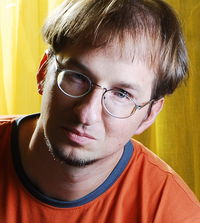Difference between revisions of "Sven Bergmann"
| Line 1: | Line 1: | ||
| − | [[File:Sven_pic. | + | [[File:Sven_pic.jpg|200px|thumb|left|Sven Bergmann, PI]] Sven Bergmann heads the ''Computational Biology Group'' in the Department of Medical Genetics at the University of Lausanne. He studied theoretical particle physics with Prof. Yosef Nir at the Weizmann Institute of Science (Israel) where he received his PhD in 2001. He then joined the laboratory of Prof. Naama Barkai in the Department of Molecular Genetics at the same institute, where he first worked as a Koshland postdoctoral fellow and later as staff scientist. His work in the field of computational biology comprised designing and applying novel algorithms for the analysis of large-scale expression data, as well as modeling of genetic networks pertaining to the development of the Drosophila embryo. He joined the Department of Medical Genetics in 2004 as Assistant Professor and leads the Computational Biology Group. He is affiliated with the Swiss Institute of Bioinformatics since 2005 and a Cavaglieri Fellow since 2006. |
---- | ---- | ||
Revision as of 10:40, 17 March 2010
Sven Bergmann heads the Computational Biology Group in the Department of Medical Genetics at the University of Lausanne. He studied theoretical particle physics with Prof. Yosef Nir at the Weizmann Institute of Science (Israel) where he received his PhD in 2001. He then joined the laboratory of Prof. Naama Barkai in the Department of Molecular Genetics at the same institute, where he first worked as a Koshland postdoctoral fellow and later as staff scientist. His work in the field of computational biology comprised designing and applying novel algorithms for the analysis of large-scale expression data, as well as modeling of genetic networks pertaining to the development of the Drosophila embryo. He joined the Department of Medical Genetics in 2004 as Assistant Professor and leads the Computational Biology Group. He is affiliated with the Swiss Institute of Bioinformatics since 2005 and a Cavaglieri Fellow since 2006.
- Address: Rue de Bugnon 27 - DGM 328 - CH-1005 Lausanne - Switzerland
- Phone at work: ++41-21-692-5452
- Cell phone: ++41-78-663-4980
- e-mail: Sven.Bergmann_AT_unil.ch
PS: Do you know how to get smoothly from A to B? Well, you just need to minimize the functional expression <math> \tilde {\cal S}[y(x)] \equiv \int_{x_i}^{x_f} \left(\kappa[y(x)]\right)^\nu \, ds(x) = \int_{x_i}^{x_f} {|y(x)|^\nu \over
\left[1+y'(x)^2\right]^{3\nu-1 \over 2}} \,dx </math>
It turns out that it is possible to find analytically the most general solution <math>y(x)</math>, see this [paper] for details.
